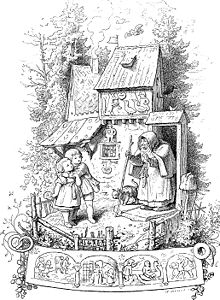Hansel and Gretel are the young children of a poor woodcutter. When a great famine settles over the land, the woodcutter's second, abusive wife decides to take the children into the woods and leave them there to be by themselves, so that she and her husband will not starve to death, because the children eat too much. The woodcutter opposes the plan but finally, and reluctantly, submits to his wife's scheme. They are unaware that in the children's bedroom, Hansel and Gretel have overheard them. After the parents have gone to bed, Hansel sneaks out of the house and gathers as many white pebbles as he can, then returns to his room, reassuring Gretel that God will not forsake them.
The next day, the family walk deep into the woods and Hansel lays a trail of white pebbles. After their parents abandon them, the children wait for the moon to rise and then they follow the pebbles back home. They return home safely, much to their stepmother's horror. Once again provisions become scarce, and the stepmother angrily orders her husband to take the children further into the woods and leave them there to die. Hansel and Gretel attempt to gather more pebbles, but find the doors locked and find it impossible to escape from their parents' house.

Illustration by Ludwig Richter, 1842
The next morning, the witch locks Hansel in an iron cage in the garden and forces Gretel into becoming a slave. The witch feeds Hansel regularly to fatten him up, but Hansel cleverly offers a bone he found in the cage (presumably a bone from the witch's previous captive) and the witch feels it, thinking it is his finger. Due to her blindness, she is fooled into thinking Hansel is still too thin to eat. After weeks of this, the witch grows impatient and decides to eat Hansel, "be he fat or lean."
She prepares the oven for Hansel, but decides she is hungry enough to eat Gretel, too. She coaxes Gretel to open the oven and prods her to lean over in front of it to see if the fire is hot enough. Gretel, sensing the witch's intent, pretends she does not understand what she means. Infuriated, the witch demonstrates, and Gretel instantly shoves the witch into the oven and slams and bolts the door shut, leaving "The ungodly witch to be burned to ashes", with the witch screaming in pain until she dies. Gretel frees Hansel from the cage, and the pair discover a vase full of treasure and precious stones. Putting the jewels into their clothing, the children set off for home. A swan ferries them across an expanse of water, and at home they find only their father; his wife died from unknown causes. Their father had spent all his days lamenting the loss of his children, and is delighted to see them safe and sound. With the witch's wealth, they all live happily ever after.
History and analysis[edit]
Jacob and Wilhelm Grimm heard "Hansel and Gretel" from Dortchen Wild[2] and published it in Kinder - und Hausmärchen in 1812.[3] In the Grimm tale, the woodcutter and his wife are the children's biological parents and share the blame for abandoning them. In later editions, some slight revisions were made: the wife is the children's stepmother, the woodcutter opposes his wife's scheme to abandon the children, and religious references are made.[4]The fairy tale may have originated in the medieval period of the Great Famine (1315–1321),[citation needed] which caused people to do some desperate deeds like abandoning young children to fend for themselves, or even resorting to cannibalism.
Folklorists Iona and Peter Opie indicate in The Classic Fairy Tales (1974) that "Hansel and Gretel" belongs to a group of European tales especially popular in the Baltic regions, about children outwitting ogres into whose hands they have involuntarily fallen. The tale bears resemblances to the first half of Charles Perrault's "Hop-o'-My-noy's "Finette Cendron" (1721). In both tales, the Opies note, abandoned children find their way home by following a trail. In "Clever Cinders", the Opies observe that the heroine incinerates a giant by shoving him into an oven in a manner similar to Gretel's dispatch of the witch, and they point out that a ruse involving a twig in a Swedish tale resembles Hansel's trick of the dry bone. Linguist and folklorist Edward Vajda has proposed that these stories represent the remnant of a coming-of-age rite-of-passage tale extant in Proto-Indo-European society.[5][6] A house made of confectionery is found in a 14th-century manuscript about the Land of Cockayne.[2]
The fact that the mother or stepmother dies when the children have killed the witch has suggested to many commentators that the mother or stepmother and the witch are metaphorically the same woman.[7] A Russian folk tale exists in which the evil stepmother (also the wife of a poor woodcutter) asks her hated stepdaughter to go into the forest to borrow a light from her sister, who turns out to be Baba Yaga, who is also a cannibalistic witch. Besides highlighting the endangerment of children (as well as their own cleverness), the tales have in common a preoccupation with food and with hurting children: the mother or stepmother wants to avoid hunger, while the witch lures children to eat her house of candy so that she can then eat them.[8] Another tale of this type is the French fairy tale The Lost Children.[9] The Brothers Grimm also identified the French Finette Cendron and Hop o' My Thumb as parallel stories.[10
Source:
http://en.wikipedia.org/wiki/Hansel_and_Gretel

No comments:
Post a Comment
We would appreciate your comments, suggestions and advice